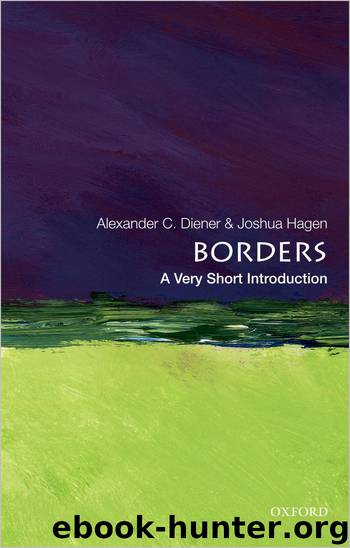Borders by unknow

Author:unknow
Language: eng
Format: epub
ISBN: 9780199731503
Publisher: Oxford University Press, USA
Published: 2012-01-15T07:00:00+00:00
Borders as permeable filters
As human constructs varying across space and time, borders and border permeability are inherently subjective phenomenon. Their specifics are shaped by legal, governmental, historical, social, political, and economic circumstances. Individual threats and pressures may increase or decrease the level of permeability for a given border at a given time. Sometimes permeability may even differ at various points along the same border.
The U.S.-Mexico border provides one interesting example. The presence of violent drug cartels in Ciudad Juarez, Mexico, triggered increased monitoring and restrictions on movement into and out of El Paso, Texas. In contrast, the border between Tijuana, Mexico, and San Diego, California, about 620 miles (1,000 kilometers) to the west, remains a relatively open portal for tourists and businesses. The relativity of border permeability is made equally clear by the ease with which economic elites cross borders in contrast to less educated and less prosperous people. This makes plain that borders function as imperfect filters reflecting both inclusive and exclusive policies, which differentiate between types of people, materials, and motives. The concept of border permeability is therefore not necessarily linked to a pursuit of freer movement. Rather it is a variable category that fluctuates between relative closure and relative openness.
To ensure profitable and ethical treatment of increasingly intense transborder flows, the goal must be to construct “good” borders. Toward this end, many would argue that “good” borders generally feature open communication, formal demarcation agreements, standing boundary commissions, accessible transportation links, and a minimal military or police presence. But “good” borders may also hinder harmful actions by neighbors or factions within neighboring states. Therefore a border’s ability to impede transboundary flows may be as essential and constructive as its bridging function. The threat of terrorism and drug trafficking combined with global economic integration and labor migration makes this point eminently clear. As state power is expanded in the name of security and simultaneously reduced under pressures for greater global economic integration, the relationship between borders and sovereignty remains profoundly unstable.
Download
This site does not store any files on its server. We only index and link to content provided by other sites. Please contact the content providers to delete copyright contents if any and email us, we'll remove relevant links or contents immediately.
| Crime | Domestic |
| Financial | Historical |
| Legal | Medical |
| Military | Psychological Thrillers |
| Spies & Politics | Supernatural |
| Suspense | Technothrillers |
The Wolf Sea (The Oathsworn Series, Book 2) by Low Robert(33986)
Crowbone (The Oathsworn Series, Book 5) by Low Robert(32453)
The Daughters of Foxcote Manor by Eve Chase(22409)
Shot Through The Heart (Supernature Book 1) by Edwin James(17994)
The Silent Patient by Alex Michaelides(17963)
The Secret History by Donna Tartt(16871)
Ready Player One by Cline Ernest(13033)
All the Missing Girls by Megan Miranda(12916)
The Betrayed by Graham Heather(11793)
The Betrayed by David Hosp(11779)
Bull's Eye Sniper Chronicles Collection (The Second Cycle of the Betrayed Series) by McCray Carolyn(11573)
Red by Erica Spindler(11512)
Kathy Andrews Collection by Kathy Andrews(10693)
Warriors (9781101621189) by Young Tom(9758)
Invisible Girl by Lisa Jewell(9486)
The Last by Hanna Jameson(9331)
Year One by Nora Roberts(8606)
Tell Tale: Stories by Jeffrey Archer(8325)
Mindhunter: Inside the FBI's Elite Serial Crime Unit by John E. Douglas & Mark Olshaker(7970)
